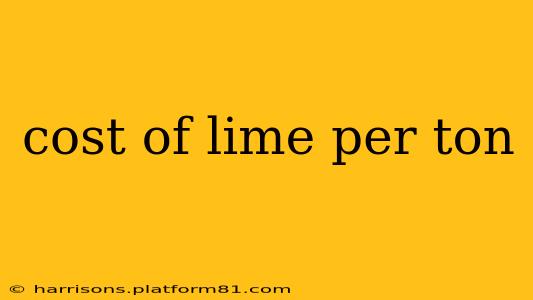The cost of lime per ton varies significantly depending on several factors. Understanding these factors is crucial for anyone looking to purchase lime for agricultural, industrial, or construction purposes. This guide will explore the key determinants of lime price and provide insights into the current market trends.
What Factors Influence the Price of Lime Per Ton?
Several factors contribute to the fluctuating price of lime per ton. These include:
-
Type of Lime: Different types of lime exist, each with its own production process and resulting cost. Quicklime (calcium oxide, CaO) and hydrated lime (calcium hydroxide, Ca(OH)2) are the most common, with quicklime generally being more expensive due to its higher energy requirements during production. The purity of the lime also impacts the price; higher purity lime commands a premium.
-
Location: Transportation costs significantly influence the final price. Lime is a heavy material, making transport over long distances expensive. Regional variations in labor costs and energy prices also play a role. Areas with abundant limestone deposits may have lower prices than those requiring long-distance transportation.
-
Quantity Purchased: Bulk purchases usually result in lower prices per ton compared to smaller orders. This is due to economies of scale in transportation and handling.
-
Market Demand: Like any commodity, lime prices are subject to market fluctuations based on supply and demand. Periods of high demand, such as during a construction boom, may see prices rise.
-
Supplier: Different suppliers may have varying pricing structures, reflecting their operational costs, market position, and business strategies. It's essential to compare prices from multiple reputable suppliers.
-
Processing and Packaging: The level of processing (e.g., grinding, screening) and packaging (e.g., bulk, bags) will affect the cost. Value-added services also add to the price.
What is the Current Market Price of Lime Per Ton?
Providing an exact current price is impossible due to the dynamic nature of the market and the factors mentioned above. However, to gain a general idea, you should contact several lime suppliers in your region and request quotes based on your specific needs (type of lime, quantity, delivery location). Online directories and industry publications may provide average price ranges, but these are often broad estimations and shouldn't be taken as definitive pricing.
How Can I Find Reliable Lime Suppliers?
To find reliable lime suppliers, you can:
- Search online directories: Many online business directories list suppliers of construction materials, including lime.
- Consult industry associations: Industry associations often maintain lists of their members, which can be a good source of potential suppliers.
- Network with other businesses: If you're in a relevant industry, networking with other businesses can lead to recommendations for reliable suppliers.
- Check online reviews: Online reviews can provide insights into the experiences of other customers.
What are the Different Types of Lime and Their Uses?
Quicklime vs. Hydrated Lime: What's the Difference?
Quicklime (CaO): Produced by heating limestone to high temperatures, quicklime reacts strongly with water. It's often used in applications requiring a rapid reaction.
Hydrated Lime (Ca(OH)₂): Created by adding water to quicklime, hydrated lime is less reactive but offers better handling characteristics. It's frequently used in applications where a gentler reaction is preferred.
Common Uses of Lime:
Lime has numerous applications across various industries, including:
- Agriculture: Soil amendment to improve pH and nutrient availability.
- Construction: Cement production, mortar, plaster, and stabilization of soil.
- Water Treatment: Neutralization of acidic water and softening of hard water.
- Industrial Processes: Pulp and paper manufacturing, steelmaking, and chemical production.
Where Can I Learn More About Lime and Its Applications?
For more detailed information on lime, its various types, and its diverse applications, you could explore resources from relevant industry associations and university agricultural extension services. These organizations often have extensive knowledge bases and educational resources about lime and its properties.
This comprehensive guide offers a detailed overview of the cost of lime per ton. Remember to contact multiple suppliers for accurate pricing based on your specific requirements. Understanding the influencing factors will help you make informed decisions when purchasing lime.
